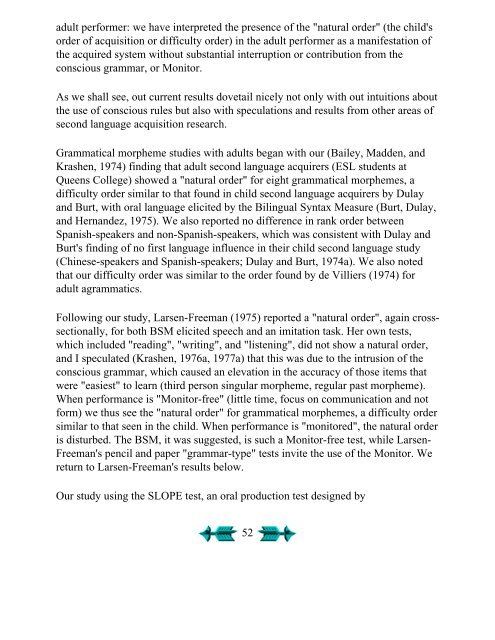Second Language Acquisition and Second ... - Stephen Krashen
Second Language Acquisition and Second ... - Stephen Krashen
Second Language Acquisition and Second ... - Stephen Krashen
Create successful ePaper yourself
Turn your PDF publications into a flip-book with our unique Google optimized e-Paper software.
adult performer: we have interpreted the presence of the "natural order" (the child's<br />
order of acquisition or difficulty order) in the adult performer as a manifestation of<br />
the acquired system without substantial interruption or contribution from the<br />
conscious grammar, or Monitor.<br />
As we shall see, out current results dovetail nicely not only with out intuitions about<br />
the use of conscious rules but also with speculations <strong>and</strong> results from other areas of<br />
second language acquisition research.<br />
Grammatical morpheme studies with adults began with our (Bailey, Madden, <strong>and</strong><br />
<strong>Krashen</strong>, 1974) finding that adult second language acquirers (ESL students at<br />
Queens College) showed a "natural order" for eight grammatical morphemes, a<br />
difficulty order similar to that found in child second language acquirers by Dulay<br />
<strong>and</strong> Burt, with oral language elicited by the Bilingual Syntax Measure (Burt, Dulay,<br />
<strong>and</strong> Hern<strong>and</strong>ez, 1975). We also reported no difference in rank order between<br />
Spanish-speakers <strong>and</strong> non-Spanish-speakers, which was consistent with Dulay <strong>and</strong><br />
Burt's finding of no first language influence in their child second language study<br />
(Chinese-speakers <strong>and</strong> Spanish-speakers; Dulay <strong>and</strong> Burt, 1974a). We also noted<br />
that our difficulty order was similar to the order found by de Villiers (1974) for<br />
adult agrammatics.<br />
Following our study, Larsen-Freeman (1975) reported a "natural order", again crosssectionally,<br />
for both BSM elicited speech <strong>and</strong> an imitation task. Her own tests,<br />
which included "reading", "writing", <strong>and</strong> "listening", did not show a natural order,<br />
<strong>and</strong> I speculated (<strong>Krashen</strong>, 1976a, 1977a) that this was due to the intrusion of the<br />
conscious grammar, which caused an elevation in the accuracy of those items that<br />
were "easiest" to learn (third person singular morpheme, regular past morpheme).<br />
When performance is "Monitor-free" (little time, focus on communication <strong>and</strong> not<br />
form) we thus see the "natural order" for grammatical morphemes, a difficulty order<br />
similar to that seen in the child. When performance is "monitored", the natural order<br />
is disturbed. The BSM, it was suggested, is such a Monitor-free test, while Larsen-<br />
Freeman's pencil <strong>and</strong> paper "grammar-type" tests invite the use of the Monitor. We<br />
return to Larsen-Freeman's results below.<br />
Our study using the SLOPE test, an oral production test designed by<br />
52











